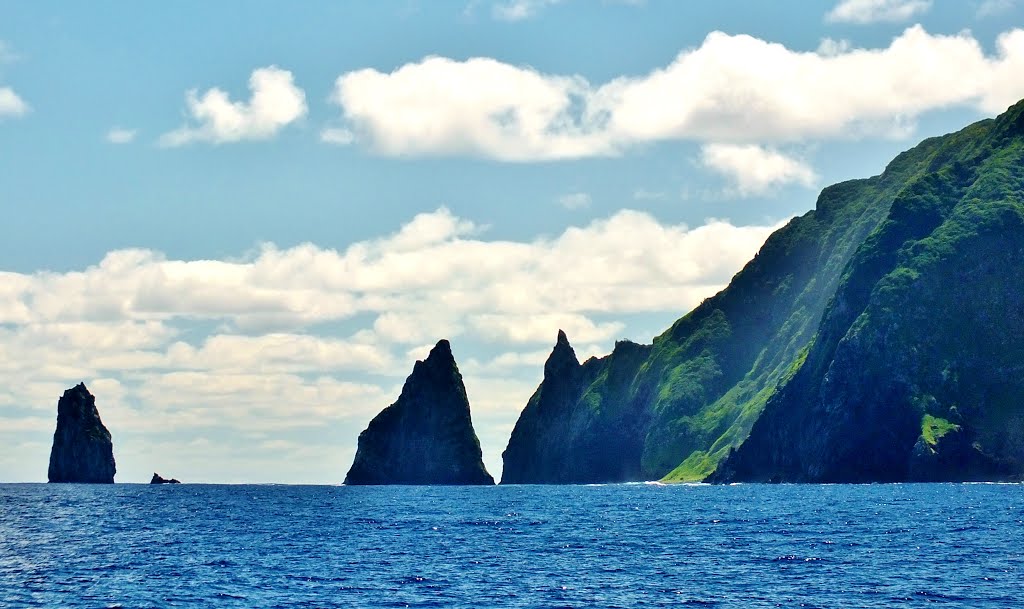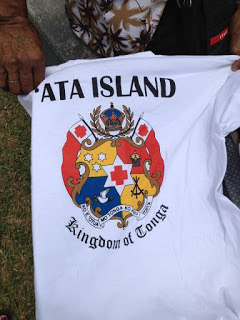On a Tongan website one person left a comment accusing me of being a descendant of the men who raided the island of 'Ata and enslaved half its people. I'm not worried about this type of comment, but I am concerned by the palangi rednecks who are either accusing me of inventing many of the details in The Stolen Island or else claiming that the book is unnecessary. These deeply conservative and rather paranoid people are convinced that there is some sort of conspiracy afoot to tarnish colonial New Zealand and the 'white race' in general, and believe that my little book is part of this grand conspiracy.
So far the conservative palangi critics of The Stolen Island have used two types of argument. The first sort of argument implicitly accepts that the slave raid on 'Ata occurred, but questions whether the raid is worth remembering today. Here's a comment that makes the argument for the insignificance of the raid:
This book is claptrap. A small incident blown out of all proportion when the real history of the Pacific is read. Journalistic excess.
I'd like to invite the people making this sort of argument to come and drink kava with some of the Tongan community in Auckland. Last Sunday I visited the kava hall attached to the Onehunga Methodist church, and listened to the Tongans gathered there talk about 'Ata. I was humbled when speakers thanked me for writing The Stolen Island, and for pushing the story of 'Ata into the consciousness of palangi New Zealanders. Nobody in the kava hall thought the enslavement of half of 'Ata's citizens a 'small incident' that had been 'blown out of proportion'. Many had ancestors who were either trapped aboard Thomas McGrath's slave ship or else forced to watch from the shore as the slavers did their work.
The raid on 'Ata was a colossal disaster for nineteenth century Tonga. In 1863 the kingdom had about twenty thousand inhabitants, so the 144 men, women, and children taken from 'Ata represented a loss of about 0.7% of its population. To take an equivalent toll a disaster in twenty-first century New Zealand would have to cost thirty thousand lives.
King Tupou I was forced to evacuate the survivors of the raid from 'Ata. The abandonment of the island was a grave setback for him, because he and his government had been trying hard to maintain Tonga's independence from European powers and the United States.
Tupou I was aware that the colonisation of many Pacific islands and archipelagoes had been justified by the claim that the indigenous authorities in those places had been incapable of protecting their people from palangi slavers and planters. He was anxious to prove that his control extended over all the islands of Tonga. He had put government representatives on almost every island, to register the ships of palangi who stopped there and to impose customs duties on them. But the raid on 'Ata forced him to withdraw his people from the southern frontier of his kingdom.
The Stolen Island also discusses the wider Pacific slave trade, which moved tens of thousands of islanders from their homelands to the plantations of Queensland, Fiji, New Caledonia, and elsewhere in the second half of the nineteenth century. This slave trade is anything but a trivial detail. Without it the Pacific would look very different.
The second type of argument contests the details of the slave raid on 'Ata. One commenter, for instance, asks how I know that 144 people were stolen from 'Ata Island:
144 is a very convenient number, [Scott] has names?
It's not clear what this commenter means by 'convenient'. Perhaps he thinks the number 144 is convenient because it is high. But the number has not been arrived at by accident.
The claim that 144 'Atans were stolen by Thomas McGrath in June 1863 was made by the great Pacific historian Henry Maude in his book Slavers in Paradise: the Peruvian slave trade in Polynesia, 1862-1864. Maude published his book in 1981, after spending years struggling through archives on several continents. His research assistant Grant McCall, who was then a graduate student at Australian National University, visited Peru and explored that country's archives, reading newspapers from the 1860s and the records of Lima's oldest hospital.
Maude and McCall were very interested in the letters that diplomats based in Peru had written during the time that the slave trade flourished in the country. Diplomats are trained to observe and report on the events in the countries where they are stationed, and British diplomats in Peru had seen and written about the slave trade.
One of the documents that Maude and McCall found in the records of the British Foreign Office was a note written by EW Robertson, who was the acting British consul in Callao, to W Stafford Jerningham, who was the incoming head of staff at the British embassy in Lima, on the 21st of July 1863. Callao was Peru's main port, and the locus of the slave trade. Polynesians had nicknamed it 'the jaws of hell'.
In his note to Jerningham Robertson explained that a boat called the General Prim had arrived at Callao and unloaded 174 people from a place the Prim's captain called the 'Frinately Islands'. 71 of them were female. The General Prim had arrived on the 19th of July.
'Frinately Islands' is an obvious mispronunciation of 'Friendly Islands', a popular nickname for Tonga, and Maude concludes that Thomas McGrath, who took slaves from the islands of 'Ata and Niuafo'ou in June 1863, must have sold his cargo to the General Prim, whose captain had sailed out from Peru looking for captives. After examining the itinerary of the General Prim in June 1863, Maude estimates that the two slave ships met somewhere near the northern Cooks island of Pukapuka.
In 1872 John Moresby captained the British naval vessel the HMS Basilisk on an anti-slaving mission. Moresby cruised through the western Pacific, searching for slavers and collecting stories about slave raids. When Moresby landed at Niuafo'ou a German trader and long-time resident on the island named Axman told him that a boat had called and asked for men who wanted to work for wages in Fiji. This offer had apparently received an enthusiastic response. The 1860s were a time of hardship and disorder on Niuafo'ou. Tupou I had recently reclaimed the island, which had been independent of Tongan control for decades, and many locals found his tax demands difficult to meet.
Thirty Niuan men had joined the boat after hearing the offer of jobs; they were never heard from again. Moresby describes his visit to Niuafo'ou in the journal he kept on the Basilisk, and in a book about his journey he published in 1876. Both the logbook entries and the book are available at the University of Auckland library (the logbook is available on microfiche, as part of the enormous Pacific Manuscripts Bureau collection).
Moresby and later Maude attributed the slave raid on Niuafo'ou to Thomas McGrath. Maude pointed out that McGrath would have been travelling close to Niuafo'ou when the raid occurred, and noted that, unlike South American slavers, he knew Tonga and Fiji well, and would have been able to construct a story about work opportunities in Fiji.
If we exclude the 30 men taken from Niuafo'ou from the 174 captives who arrived at Callao on the General Prim on the 19th of July 1863, then we can guess that the ship held 144 'Atans - 73 of them male, 71 of them female.
EW Robertson's report from Callao sits fairly well with the eyewitness report on the raid of 'Ata that was given by John Bryan, the ship's cook. In an article published in the Melbourne Leader on the 28th of November 1863 and then republished in many Australasian papers, Bryan was reported as saying that the 'Atans came aboard McGrath's ship to trade, and that they were tricked into going below deck to eat a meal before being locked up. Bryan said that 'about 130' islanders were taken captive.
I hope all this makes it clear why I say in The Stolen Island that at least 144 'Atans were stolen from their island in June 1863.
Footnote: I have been focusing on the traces that the slave raids of 1863 left in palangi archives, but there are other ways of remembering history.
The survivors of the slave raid and their descendants have told and continue to tell many stories about the tragedy. In the late nineteenth and early twentieth century some of these stories were written down by palangi, and published in Australasian newspapers. Usually the stories published in papers do not give estimates of the number of 'Atans taken by the slave raid, but there are one or two exceptions to this rule.
In his article 'Atata and Ata', which was published in two parts by the New Zealand Herald in 1903, Walter Parker claims that 'about a hundred men' boarded McGrath's ship and were taken away to slavery. Parker was for many years a sheep farmer on 'Eua, the island where the survivors of the slave raid of 1863 were resettled by Tupou I, and his very detailed article was probably based on stories he heard from 'Atans. Some of the story's details are nevertheless wrong, and Parker's freely expressed prejudices about Tongans make him a problematic recorder of the Tongan past.
[Posted by Scott Hamilton]








